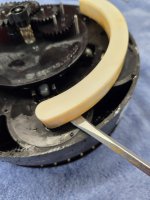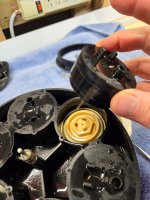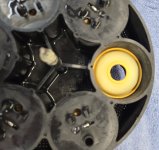- May 24, 2023
- 11
- Pool Size
- 30000
- Surface
- Plaster
- Chlorine
- Salt Water Generator
- SWG Type
- Hayward Aqua Rite (T-15)
First TFP post...
Seven years ago, I fell in love with a pool that came with a girl...errrrr, the other way around. The first year I respectfully watched her netting and sweeping the pool virtually everyday. She said it was "therapeutic"...and I gave her the benefit of the doubt . As an engineer (electrical, since retired), my curiosity eventually got the better of me and I started poking around the pool to see how it worked. I was truly starting from scratch; the extent of my pool knowledge was growing up watching the lifeguards at the local pool do red, green, and blue chemistry.
. As an engineer (electrical, since retired), my curiosity eventually got the better of me and I started poking around the pool to see how it worked. I was truly starting from scratch; the extent of my pool knowledge was growing up watching the lifeguards at the local pool do red, green, and blue chemistry.
From the start it was obvious watching those pop-up thingamajigs in the pool floor that they were not operating as intended...some never popped up and one was always up...that just couldn't be right. It didn't take long to get schooled up on those pop-ups, valve modules, skimmers, drains, pumps, etc. and figure out that the IFCS (PCC2000: 8 rotating heads, 2 pairs of down jets, and two stationary drain-oriented heads) had suffered from years of neglect...a lot of my SO's "therapy" was making up for the fact that the IFCS needed some serious attention. So I got the head removal tool, cleaned the debris from the rescue-able heads, replaced the broken heads, and replaced both the 4-port and 6-port valve modules. Viola, no more "therapy" needed. By the way, as I was schooling myself on the PCC2000, the tech support at Paramount provided tons of excellent info...I had many fruitful email exchanges with them...they are super helpful...they even provided a copy of the design drawing that they did for the pool builder (who could have done a better job following the drawing (another thread!).
Over the intervening years, having moved in with thepoolgirl, I've had to replace each valve module (I guessing) two times...that's roughly $1K of replacements because I couldn't find a rebuild kit or any info anywhere online on how to do it. Most recently, I replaced the 6-port valve module a week ago...it had, at least in my case, the classic single drooping valve head (ie, it would not lift up flush to the bottom plate of the valve module) which resulted in one pop-up always staying up, I had to buy a new valve module when only 1 of 6 ports was broken...arrrgghhh.
Tired of spending the $$$ (and yes, I'm that guy...probably more so than the $$$), I decided to tear down the broken valve module (what's there to lose?). It took a lot of head scratching but I finally got the problematic port disassembled along with a good port so I could do a comparison (getting out of an Escape Room is easier). (Lotta guessing to follow so mentally add "appears" to each sentence. And I will claim credit for cases where I get something right for the wrong reason ).
).
The problem seems to be with a rubber piece that is shaped like the screw-on retainer ring on a baby bottle...I'll call it a bellows for lack of a better term. I think that the molded shape of the bellows makes it act like a spring that keeps the valve head closed against the bottom plate of the valve module to cut off water to that port. On the problematic port, the bellows had lost its springy mojo and sagged letting the valve head droop and water pass through. On the good port, the bellows still has its springy mojo and kept the valve head in place. I guess that perhaps the problematic bellows could have a hole causing it to lose pressure and sag but looking at the construction, it doesn't look like the bellows is part of an airtight space...but who knows. (Something makes me mentally compare the overall design to that of a balanced scuba regulator.)
So, what's next? Sooner or later another valve head on one of my two valve modules will fail. Instead of throwing this broken valve module away like I have in the past, I will stash it away to use for spare parts for the next valve module failure. If that stinking 50-cent bellows is indeed the problem, I'll replace it with a used, working bellows from my spare valve module to see if it fixes the broken valve head. I'm more than willing to spend $500 dollars of my time to save $250!
Over the next week or so, in the event that someone is interested, I'll post some pictures showing the disassembly steps along with both a good and a problematic bellows.
If anyone else has some experience with this, I sure would appreciate it if you would add a reply to this thread. I hope I'm not reinventing the wheel but I couldn't find any posts on this other than people asking the "can I repair it question" and always ending up buying a new valve module. Apologies in advance if this is common knowledge.
Wish me luck.
PS. The Europeans' Right-to-Repair laws should be imported (as well, regarding our proposals, if its good enough for farm equipment, it should be good enough for lotsa stuff).
Seven years ago, I fell in love with a pool that came with a girl...errrrr, the other way around. The first year I respectfully watched her netting and sweeping the pool virtually everyday. She said it was "therapeutic"...and I gave her the benefit of the doubt
 . As an engineer (electrical, since retired), my curiosity eventually got the better of me and I started poking around the pool to see how it worked. I was truly starting from scratch; the extent of my pool knowledge was growing up watching the lifeguards at the local pool do red, green, and blue chemistry.
. As an engineer (electrical, since retired), my curiosity eventually got the better of me and I started poking around the pool to see how it worked. I was truly starting from scratch; the extent of my pool knowledge was growing up watching the lifeguards at the local pool do red, green, and blue chemistry.From the start it was obvious watching those pop-up thingamajigs in the pool floor that they were not operating as intended...some never popped up and one was always up...that just couldn't be right. It didn't take long to get schooled up on those pop-ups, valve modules, skimmers, drains, pumps, etc. and figure out that the IFCS (PCC2000: 8 rotating heads, 2 pairs of down jets, and two stationary drain-oriented heads) had suffered from years of neglect...a lot of my SO's "therapy" was making up for the fact that the IFCS needed some serious attention. So I got the head removal tool, cleaned the debris from the rescue-able heads, replaced the broken heads, and replaced both the 4-port and 6-port valve modules. Viola, no more "therapy" needed. By the way, as I was schooling myself on the PCC2000, the tech support at Paramount provided tons of excellent info...I had many fruitful email exchanges with them...they are super helpful...they even provided a copy of the design drawing that they did for the pool builder (who could have done a better job following the drawing (another thread!).
Over the intervening years, having moved in with the
Tired of spending the $$$ (and yes, I'm that guy...probably more so than the $$$), I decided to tear down the broken valve module (what's there to lose?). It took a lot of head scratching but I finally got the problematic port disassembled along with a good port so I could do a comparison (getting out of an Escape Room is easier). (Lotta guessing to follow so mentally add "appears" to each sentence. And I will claim credit for cases where I get something right for the wrong reason
The problem seems to be with a rubber piece that is shaped like the screw-on retainer ring on a baby bottle...I'll call it a bellows for lack of a better term. I think that the molded shape of the bellows makes it act like a spring that keeps the valve head closed against the bottom plate of the valve module to cut off water to that port. On the problematic port, the bellows had lost its springy mojo and sagged letting the valve head droop and water pass through. On the good port, the bellows still has its springy mojo and kept the valve head in place. I guess that perhaps the problematic bellows could have a hole causing it to lose pressure and sag but looking at the construction, it doesn't look like the bellows is part of an airtight space...but who knows. (Something makes me mentally compare the overall design to that of a balanced scuba regulator.)
So, what's next? Sooner or later another valve head on one of my two valve modules will fail. Instead of throwing this broken valve module away like I have in the past, I will stash it away to use for spare parts for the next valve module failure. If that stinking 50-cent bellows is indeed the problem, I'll replace it with a used, working bellows from my spare valve module to see if it fixes the broken valve head. I'm more than willing to spend $500 dollars of my time to save $250!
Over the next week or so, in the event that someone is interested, I'll post some pictures showing the disassembly steps along with both a good and a problematic bellows.
If anyone else has some experience with this, I sure would appreciate it if you would add a reply to this thread. I hope I'm not reinventing the wheel but I couldn't find any posts on this other than people asking the "can I repair it question" and always ending up buying a new valve module. Apologies in advance if this is common knowledge.
Wish me luck.
PS. The Europeans' Right-to-Repair laws should be imported (as well, regarding our proposals, if its good enough for farm equipment, it should be good enough for lotsa stuff).
Last edited:




























